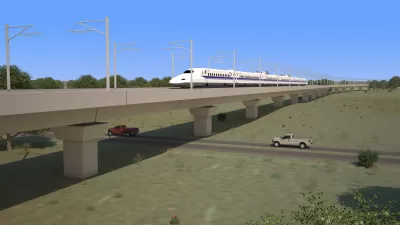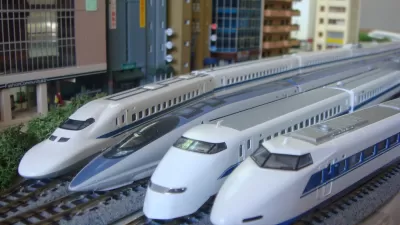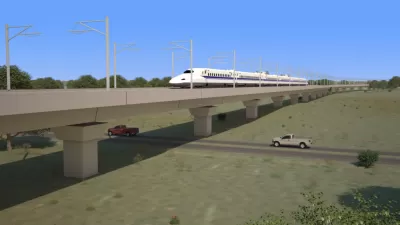A Texas mall that opened in 1968 and largely closed ten months ago has been picked by Texas Central Partners as the Houston terminal of the Dallas-to-Houston high-speed rail. The site is far from downtown and distant from public transit.

The Texas Bullet Train appears to forgo one of the great advantages of high-speed rail: easy access from downtown to train terminals, on both ends of the line as well as the one intermediate stop.
The 45-acre site of Houston's Northwest Mall, which operated for almost half a century before largely closing last March, may see new life with the announcement Monday by Texas Central Partners (TCP) and Houston-area elected officials that it has been selected "as its preferred site for the southern terminal" of the 240-mile Dallas-to-Houston high-speed rail line, reports Dug Begley for the Houston Chronicle. Three renderings of the station are available in the article.
The announcement was timed to coincide with a public hearing Monday night in Cypress [unincorporated community in Harris County, pop. 123,000] on the high-speed rail line, where critics lined up to lament the plan, which calls for trains on elevated tracks.
The site, about eight miles northwest from downtown Houston, was one of three that TCP was considering, though the other two were near the aging mall, reports Brandon Formby for The Texas Tribune.
The chosen location is about 1.5 miles from Northwest Transit Center, a major bus hub and the closest public transportation connection. Despite that distance, the company said in a prepared statement Monday that the station will provide “convenient, efficient and direct” connections to the Houston METRO transit system.
Texas Central President Tim Keith said the company chose the aging mall, which only has a few open stores left, because of its proximity to existing roads and highways.
As for the southern, Dallas station, "Texas Central said the terminal will be built on a largely vacant 60-acre plot south of the Kay Bailey Hutchison Convention Center in the revitalized Cedars neighborhood, near the Interstate 30 and Interstate 35 interchange," states the company's Jan. 29 press release [pdf].
The 90-minute ride from Dallas to Houston will have only one intermediate stop, in Brazos Valley near Texas A&M University, reports The Jewett Messenger on Jan. 29. [See map of route showing all three stations].
Texas Central said the terminal will be built on 60 acres in the Roans Prairie area of Grimes County, ideally located along Highway 30 and just west of Highway 90, about equidistant between College Station and Huntsville.
"The project, expected to cost between $15 billion and $18 billion to build, must receive federal approval to proceed, even though it is privately funded," adds Begley for the Chronicle. Construction should begin next year.
Hat tip to Lauren Gardner of POLITICO Morning Transportation.
FULL STORY: Northwest Mall could gain new life as terminal for Houston-Dallas bullet train

Trump Administration Could Effectively End Housing Voucher Program
Federal officials are eyeing major cuts to the Section 8 program that helps millions of low-income households pay rent.

Planetizen Federal Action Tracker
A weekly monitor of how Trump’s orders and actions are impacting planners and planning in America.

Ken Jennings Launches Transit Web Series
The Jeopardy champ wants you to ride public transit.

Rebuilding Smarter: How LA County Is Guiding Fire-Ravaged Communities Toward Resilience
Los Angeles County is leading a coordinated effort to help fire-impacted communities rebuild with resilience by providing recovery resources, promoting fire-wise design, and aligning reconstruction with broader sustainability and climate goals.

When Borders Blur: Regional Collaboration in Action
As regional challenges outgrow city boundaries, “When Borders Blur” explores how cross-jurisdictional collaboration can drive smarter, more resilient urban planning, sharing real-world lessons from thriving partnerships across North America.

Philadelphia Is Expanding its Network of Roundabouts
Roundabouts are widely shown to decrease traffic speed, reduce congestion, and improve efficiency.
Urban Design for Planners 1: Software Tools
This six-course series explores essential urban design concepts using open source software and equips planners with the tools they need to participate fully in the urban design process.
Planning for Universal Design
Learn the tools for implementing Universal Design in planning regulations.
Ada County Highway District
Clanton & Associates, Inc.
Jessamine County Fiscal Court
Institute for Housing and Urban Development Studies (IHS)
City of Grandview
Harvard GSD Executive Education
Toledo-Lucas County Plan Commissions
Salt Lake City
NYU Wagner Graduate School of Public Service





























